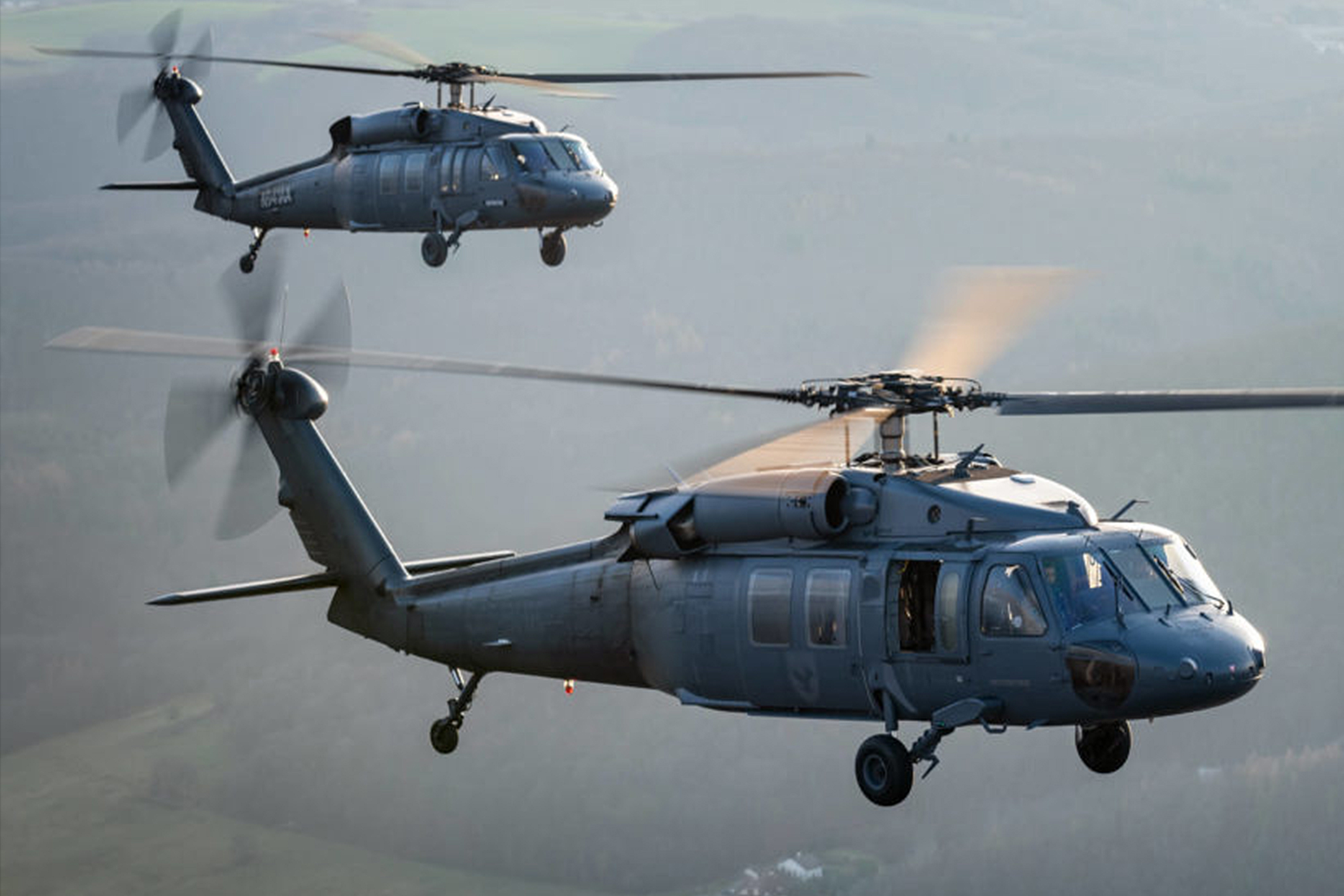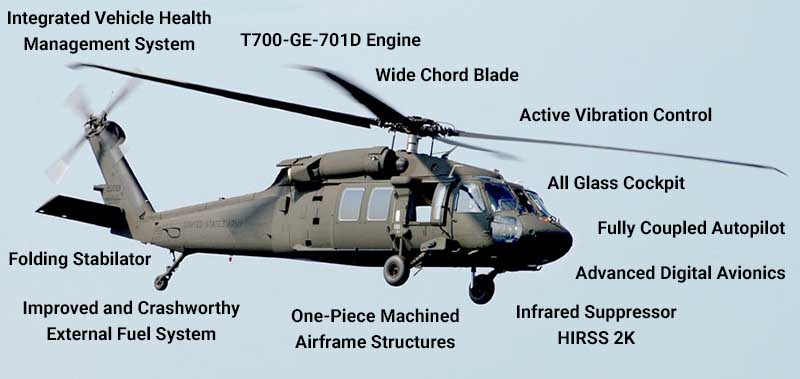The UH 60: A Check out Its Duty in Modern-Day Military Missions
The UH 60: A Check out Its Duty in Modern-Day Military Missions
Blog Article
UH-60: Technologies in Modern Helicopter Layout
The UH-60 helicopter stands as a standard in contemporary aviation, showcasing significant advancements in layout and innovation that accommodate the developing needs of armed forces operations. Its incorporation of innovative products not only enhances efficiency however likewise addresses vital security problems. The combination of advanced avionics has changed functional capacities, permitting for greater situational awareness and decision-making efficiency. As we check out the development and vital developments of the UH-60, it becomes vital to take into consideration just how these developments influence not only present applications yet also the future landscape of helicopter style.

Advancement of the UH-60
The development of the UH-60 Black Hawk helicopter stands for a significant turning point in aerospace design and military air travel. Presented in the late 1970s, the UH-60 was designed by Sikorsky Airplane to fulfill the United States Military's demand for a functional energy helicopter efficient in doing a range of goals. Its style emphasized ability to move, toughness, and speed, setting new requirements for functional performance.
The UH-60 includes an unique four-blade blades system, which enhances lift and stability, allowing it to operate properly in diverse settings. Its airframe is built from advanced composite products, adding to a reduction in weight while maintaining structural integrity. The helicopter's design also includes enhanced aerodynamics, which improves gas efficiency and boosts range.
For many years, the Black Hawk has actually undergone multiple upgrades to boost its capacities, consisting of enhanced engines, progressed trip control systems, and modular systems for simple maintenance and versatility. The helicopter's ability to carry out objectives varying from troop transport to medical evacuation has actually strengthened its function as a backbone of united state army procedures. The UH-60 Black Hawk remains an archetype of exactly how innovation in helicopter style can dramatically affect army efficiency and functional flexibility.
Advanced Avionics Equipments
Improvements in avionics systems have changed the abilities of modern helicopters like the UH-60 Black Hawk, improving functional performance and situational awareness (UH 60). The assimilation of sophisticated avionics permits enhanced navigation, flight, and communication administration, making the UH-60 extra flexible in varied mission profiles
Among the essential functions is the advanced electronic cockpit, which employs multifunction displays that provide real-time data, making sure pilots have immediate accessibility to crucial trip information. This streamlining of info reduces pilot workload and enhances decision-making procedures during complicated operations. Furthermore, the incorporation of general practitioner and inertial navigation systems makes it possible for accurate positioning and path planning, enhancing mission implementation in challenging atmospheres.
Additionally, advanced avionics systems boost communication capabilities with secure information web links and voice communication systems, allowing seamless coordination with ground forces and other airplane. The assimilation of automatic trip control systems even more contributes to enhanced security and control, especially in negative weather conditions or during low-altitude maneuvers.
Engine and Efficiency Enhancements
Engine performance in contemporary helicopters has actually taken a significant leap forward, driven by developments that improve power, dependability, and efficiency. The UH-60 Black Hawk, for circumstances, makes use of the T700-GE-701C engine, which features a dual-channel, full-authority digital engine control system.
Furthermore, the assimilation of engine health monitoring systems permits real-time diagnostics and anticipating maintenance, substantially boosting operational dependability. These systems not just alert crews to possible concerns before they come to be important but also assist in extra reliable maintenance organizing, thus minimizing downtime.

Products and Structural Innovations
Current developments in materials and structural layout have changed modern helicopter building and construction, enhancing both performance and sturdiness. The introduction of advanced composite products, such as carbon fiber reinforced polymers, has substantially minimized weight while maintaining architectural stability. This change not only boosts gas effectiveness yet also raises haul ability, permitting helicopters like the UH-60 to do more varied missions.
Additionally, advancements in light weight aluminum alloys and titanium parts have actually added to improved resistance to deterioration and fatigue, extending the life expectancy of essential airframe aspects. view publisher site The critical use these materials has actually resulted in a reduction in maintenance needs and enhanced total functional preparedness.

In addition, the assimilation of computer-aided design (CAD) and additive manufacturing modern technologies has made it possible for a lot more light-weight frameworks and intricate geometries, optimizing the wind resistant efficiency of helicopter layouts. These advancements facilitate fast prototyping and production, enabling producers to react quickly to advancing objective requirements.
Safety And Security and Survivability Attributes
Safety and security and survivability features in modern helicopter design have ended up being vital, mirroring the increasing demands for goal effectiveness in challenging environments. The UH-60 Black Hawk, a notable example, integrates sophisticated technologies to improve staff and guest protection. One of the most crucial developments is the incorporation of crashworthy gas systems created to decrease the threat of fire during influence. Furthermore, the airframe is constructed with enhanced products that dissipate and absorb energy, more safeguarding occupants in case of an accident.
The helicopter likewise employs a ballistic protection system, that important source includes armored staff seats and vital systems securing, minimizing vulnerability to tiny arms fire and shrapnel. Boosted situational recognition is attained via innovative avionics and sensor modern technologies, allowing pilots to spot and stay clear of threats properly.
In addition, the assimilation of redundancy in crucial systems-- such as double engines and multiple trip control networks-- makes sure continued operation even if one system stops working. The UH-60 is geared up with sophisticated emergency situation flotation protection tools, enhancing survivability in water touchdowns. Jointly, these attributes not only boost the security of personnel however likewise increase goal success rates in hostile environments, demonstrating the dedication to quality in helicopter style.
Conclusion
The UH-60 helicopter stands for a considerable advancement in contemporary aviation innovation, integrating innovative products, advanced avionics, and durable safety functions. Its evolution mirrors a commitment to enhancing performance and functional effectiveness while ensuring pilot and staff survivability. The combination of lightweight composites and advanced navigation systems emphasizes the helicopter's flexibility in different armed forces missions. Generally, the UH-60 functions as a benchmark for future advancements in helicopter style, embodying resilience and adaptability in modern armed forces procedures.
The UH-60 helicopter stands as a benchmark in modern-day aviation, showcasing significant improvements in layout and innovation that provide to the progressing demands of army operations. As we check out the page advancement and essential developments of the UH-60, it ends up being necessary to take into consideration how these advancements affect not just current applications yet likewise the future landscape of helicopter design.
Introduced in the late 1970s, the UH-60 was created by Sikorsky Aircraft to fulfill the United States Army's requirement for a versatile utility helicopter qualified of carrying out a variety of goals. The UH-60 Black Hawk remains a prime instance of how development in helicopter style can dramatically influence military performance and operational versatility.
On the whole, the UH-60 serves as a benchmark for future advancements in helicopter design, embodying durability and flexibility in contemporary military operations.
Report this page